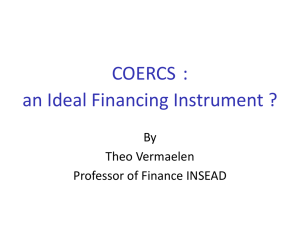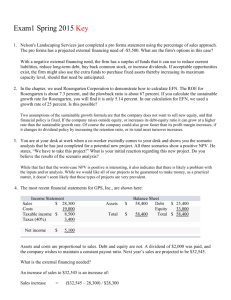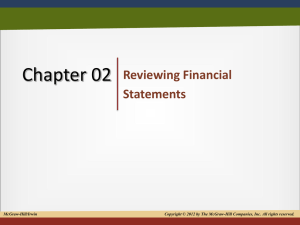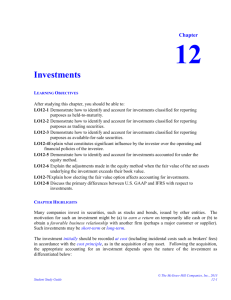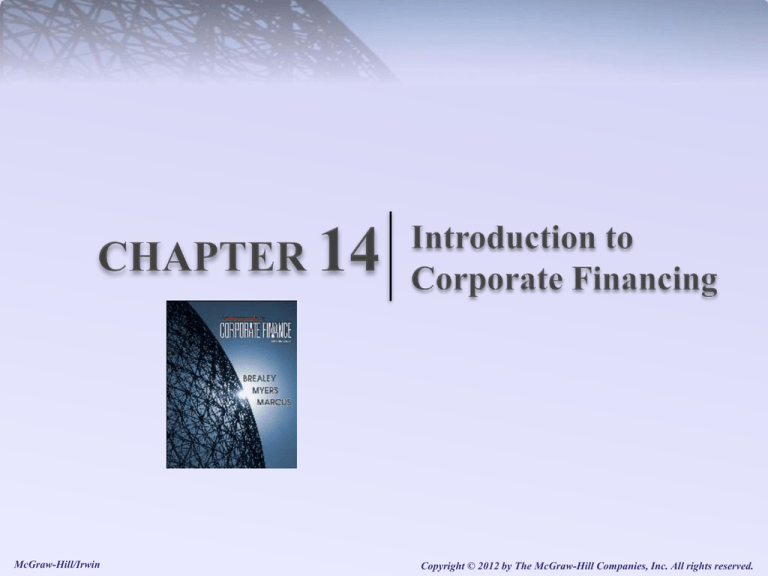
McGraw-Hill/Irwin
Copyright © 2012 by The McGraw-Hill Companies, Inc. All rights reserved.
Lecture 4
Introduction to Corporate
Financing
Firms have three sources of cash from which to
finance their activities.
This chapter provides an overview of debt,
equity, and internally generated funds.
14-2
Financial Markets
Competition in financial markets is fierce-much more so than in product markets.
Few protected niches (ex: cannot patent the
structure of a new security)
Securities sell for their true values
True value – a price that incorporates all the
information currently available to investors
14-3
Corporate Financing
Firms have three broad sources of cash.
Internally generated funds – Cash reinvested
in the firm: depreciation plus earnings not paid
out as dividends.
New equity issues
New debt issues
14-4
Internally Generated Funds
Historical sources of funds for FedEx
1995-2010
14-5
Why Internal Funds?
Managers prefer to reinvest internal funds for a
number of reasons:
Cost of issuing securities
New equity announcement implications
•
The announcement of a new equity issue
is usually bad news for investors.
•
Can be perceived as an attempt by
management to sell overpriced stock.
14-6
Corporate Financing
What happens when the firm cannot finance all
of its activities from plowed-back funds?
Financial Deficit
•The difference between the cash a company
needs and the amount generated internally.
•
To fix this deficit, firms either issue new equity or
issue new debt.
New Equity Issues
New Debt Issues
14-7
Equity Issues
Most corporations are too large to be owned by
one investor; therefore they issue stock to many
investors.
Example:
Dow is owned by 650,000 different investors. If it has 1.167
billion shares outstanding, how much of Dow does an
investor who holds one share own?
The investor owns:
, or 0.000000085% of Dow
14-8
Equity Terminology
Treasury stock
• Stock that has been repurchased by the company and held in its
treasury.
Issued shares and Outstanding Shares
• Shares that have been issued by the company; shares that have
been issued by the company and are held by investors.
Authorized Share Capital
• The maximum number of shares that the company is permitted to
issue without additional shareholder approval.
14-9
Equity Terminology: Example
Imagine a firm has 100 million shares currently trading on
the NYSE. The firm issues 20 million new shares, and
repurchases 5 million shares one month later.
What is the total change in treasury stock?
What is the total change in the number of issued shares?
What is the total change the number of shares outstanding?
14-10
Equity Terminology
When a firm issues new equity, it records each
new share in its books at par value.
Additional Paid-in Capital
• The difference between the issue price and the par
value of a stock
Retained Earnings
• Earnings not paid out as dividends
14-11
Equity Terminology: Example
Suppose a firm has recently issued 10 million new shares at
$15 per share; the par value of each is $1.50.
What is the value of additional paid-in capital (APIC)?
14-12
Net Common Equity
Represents the total amount contributed directly by shareholders
when the firm issued new stock, and contributed indirectly when it
plowed back part of its earnings
Net Common
Par
Additional
Retained
= Value + Paid-in Capital + Earnings
Equity
-
Share
Repurchases
14-13
Net Common Equity: Example
What is the book value per share of equity for a firm with
$1 million in net common equity; $50,000 in authorized
share capital; 25,000 shares issued; and 20,000 shares
outstanding?
14-14
Corporate Ownership
A corporation is owned by its common stockholders.
Owners are entitled to:
Profits
• The shareholders are entitled to whatever profits are left over after the lenders have
received their dues.
• A portion of profits are usually paid out in dividends and the rest is plowed back into the
firm.
• Plowed back profits should allow the company to earn higher profits and pay
higher dividends in the future.
•
Control of the firm
Shareholders retain all residual rights of control over the operation of the firm
14-15
Corporate Ownership
Shareholders exercise control over the firm by voting for its
board of directors.
• Majority Voting
•
Voting system in which each director is voted on separately
• Cumulative Voting
•
Voting system in which all votes that one shareholder is
allowed to cast can be cast for one candidate for the board
of directors
• Proxy Contest
•
Takeover attempt in which outsiders compete with
management for shareholders’ votes
14-16
Corporate Ownership: Example
A shareholder owning 100 shares of stock is voting for the
board of directors who are elected by cumulative voting. How
many votes did the shareholder cast for Director 'A' if four
directors are to be elected and the shareholder cast his/her
maximum number of votes for 'A'?
400
14-17
Preferred Stock
Preferred Stock Advantages:
•
Dividends
•
Tax Advantages:– If one corporation buys another’s stock, only 30% of
the dividends it receives is taxable.
•Disadvantages:
Potential Disadvantages:
•
Interest rate fluctuations: Interest rate fluctuations – As interest rates rise, the
present value of the preferred securities falls. This problem is solved with
floating-rate preferred shares.
•
Floating Rate Preferred: – Preferred stock paying dividends that vary with
short-term interest rates
14-18
Corporate Debt
When issuing debt, companies promise to make payments
and repay principal. But they have limited liability; debt
is not always repaid.
14-19
Debt Characteristics
Interest rate fluctuations
Coupon vs. Zero-coupon Bonds
•
Prime Rate – Benchmark interest rate charged by banks.
•
LIBOR – London Interbank Offered Rate; the rate at which international banks lend to
one another.
Would you expect the price of a 10-year floating-rate bond
to be more or less sensitive to changes in interest rates
than the price of a 10-year fixed-rate bond?
14-20
Debt Characteristics
Funded and Unfunded Debt
• Debt with more than 1 year remaining to maturity; debt due
in less than one year.
Sinking Fund
• A fund established to retire debt before maturity.
Callable Bond
• A bond that may be repurchased by a firm before maturity
at a specified call price.
If interest rates rise, would holders of callable bonds expect
the firm to buy back the debt?
14-21
Debt Characteristics
Seniority
• Subordinated Debt – Debt that may be repaid in bankruptcy only after senior debt is
paid.
Security
• Secured Debt – Debt that has first claim on specified collateral in the event of default.
Currency and Country of Origin
• Eurodollars – Dollars held on deposit in a bank outside the United States.
• Eurobond – Bond that is marketed internationally.
14-22
Debt Characteristics
Public vs. Private Placements
• Publicly issued bonds are sold to anyone who wishes to buy, and are resold and traded in
securities markets.
• Private Placement – Sale of securities to a limited number of investors without a public
offering.
Protective Covenants
• Restrictions on a firm to protect bondholders
Leases
• Long-term rental agreements
14-23
Convertible Securities
Give investors the option to alter their investments
if they so choose.
Warrant
• The right to buy shares from a company at a stipulated
price before a set date
Convertible Bond
• A bond that the holder may exchange for a specified
amount of another security
14-24
Convertible Securities: Example
An investor owns a bond selling for $1,000. This bond can
be converted to 20 shares of stock that are currently selling
for $55 per share. Should the investor convert his bond into
shares?
Without conversion:
With conversion:
14-25







